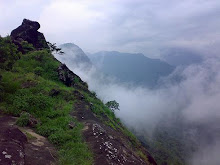 A volcano is a place on the Earth's surface (or any other planet's or moon's surface) where molten rock, gases and pyroclastic debris erupt through the earth's crust. Volcanoes vary quite a bit in their structure - some are cracks in the earth's crust where lava erupts, and some are domes, shields, or mountain-like structures with a crater at the summit.
A volcano is a place on the Earth's surface (or any other planet's or moon's surface) where molten rock, gases and pyroclastic debris erupt through the earth's crust. Volcanoes vary quite a bit in their structure - some are cracks in the earth's crust where lava erupts, and some are domes, shields, or mountain-like structures with a crater at the summit.Magma is molten rock within the Earth's crust. When magma erupts through the earth's surface it is called lava. Lava can be thick and slow-moving or thin and fast-moving. Rock also comes from volcanoes in other forms, including ash (finely powdered rock that looks like dark smoke coming from the volcano), cinders (bits of fragmented lava), and pumice(light-weight rock that is full of air bubbles and is formed in explosive volcanic eruptions - thistype of rock can float on water). Volcanic eruptions can cause great damage and the loss of life and property.
The Word Volcano:
The word volcano comes from the Roman god of fire, Vulcan. Vulcan was said to have had a forge (a place to melt and shape iron) on Vulcano, an active volcano on the Lipari Islands in Italy.
Extreme Volcanoes:
The largest volcano on Earth is Hawaii's Mauna Loa. Mauna Loa is about 6 miles (10 km) tall from the sea floor to its summit (it rises about 4 km above sea level). It also has the greatest volume of any volcano, 10,200 cubic miles (42,500 cubic kilometers). The most active volcano in the continental USA is Mt. St. Helens (located in western Washington state). The largest volcano in our Solar System is perhaps Olympus Mons on the planet Mars. This enormous volcano is 17 miles (27 km) tall and over 320 miles (520 km) across.
Biggest irruption
Supervolcano eruptions are the greatest in the world in volume of ash released. They aren't in Ginness because nobody watched them: the youngest is 70,000 years old. When another occur, it will be the deadliest in history.
The largest volcanic eruption in recorded history is that out Mount Tambora on Sumbawa island, Indonesia. Taking place on 10 April 1815, the eruption was so loud it sounded like a a gunshot to people on the island of Sumatra, 2,600 km (1,615 mi away). Only one larger eruption has occurred in the last three thousand years: that of Mt. Taupo, New Zealand in 181 CE. However, because no historians — in fact, no humans at all — were on New Zealand at the time, the largest volcanic eruption in history remains Mt. Tambora. Signs of the eruption began when a dark cloud of ash formed over the mountain and the ground started to rumble. Several minor eruptions occurred over several days. Thousands watched the eruption unfold. At 7 PM on 10 April, three columns of flame "rose up and merged" and the mountain was turned into "liquid fire". About 100 km3 (38.6 mi3) of pyroclastic trachyandesite was ejected, enough to qualify as a 7 on the Volcanic Explosivity Index. All vegetation on the island was destroyed. 10,000 people were killed in the pyroclastic flows.
The eruption ejected enough ash into the upper atmosphere to block part of the light from the Sun for months on end. This caused 1816 to be called The Year without a summer, in which crops failed worldwide and at least 300,000 people starved or froze. On the plus side, the atmospheric dust from the volcanic explosion caused interesting optical effects, including the most spectacular sunsets in history.
The Year Without a Summer was harsh. Two huge snowstorms hit eastern Canada and New England dead in the middle of June. Nearly a foot of snow fell in Quebec City. As a result, the price of oats and other grains increased by about 700%. The event was called "the last great subsistence crisis in the Western world."
Although the explosion of Mt. Tambora was large, it is not the largest volcanic eruption in all of human history — just recorded history. The largest volcanic eruption in all human history is that of the former Mt. Toba Young Toba Tuff (Toba, Sumatra Island, 70,000 years ago): Released between 2500 and 3000 cubic km of ash, nearly extincted early humans.This was about 28 times larger than the 1815 eruption, and it is believed that the global human population may have been reduced to as few as 1,000 breeding pairs in the aftermath of the event.
The largest volcanic eruption in the history of the Earth were probably the series of eruptions 251 million years ago that created the Siberian Traps, a rock formation in what is now Russia. These eruptions lasted about a million years and released almost enough lava to cover the continent of Australia in a layer 1,000 m deep. This event resulted in the greatest mass extinction in Earth's history, during which 96 percent of all marine species and 70 percent of terrestrial vertebrates were wiped out.

Post a Comment